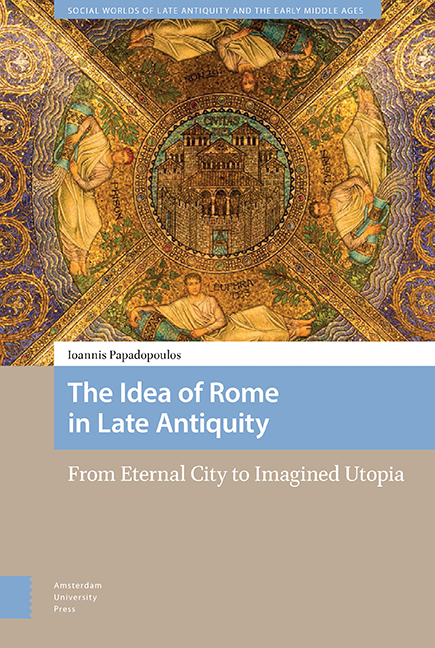Book contents
- Frontmatter
- Dedication
- Contents
- Introduction: Between a Physical and an Imaginary City
- I Looking Backwards: Ordo Renascendi
- II The Adventus of Constantius
- III Between Rome and Athens: The Artificial Romanitas of Julian
- IV Between the Altar and the Court: Symmachus and Claudian in Action
- V Between Christ and a Roman Place: The Emergence of Christian Rome in Time and Space
- VI Between Jerusalem and Babylon: The Archetype of Rome in the City of God
- Conclusions: From Rome to Eternity
- Bibliography
- Index
VI - Between Jerusalem and Babylon: The Archetype of Rome in the City of God
Published online by Cambridge University Press: 11 November 2021
- Frontmatter
- Dedication
- Contents
- Introduction: Between a Physical and an Imaginary City
- I Looking Backwards: Ordo Renascendi
- II The Adventus of Constantius
- III Between Rome and Athens: The Artificial Romanitas of Julian
- IV Between the Altar and the Court: Symmachus and Claudian in Action
- V Between Christ and a Roman Place: The Emergence of Christian Rome in Time and Space
- VI Between Jerusalem and Babylon: The Archetype of Rome in the City of God
- Conclusions: From Rome to Eternity
- Bibliography
- Index
Summary
The sack of the eternal city by the forces of Alaric left a deep scar (in contrast to the actual material damage) on the intellectual landscape of the West. This acceleration of history and the confirmation of the more pessimistic voices regarding the fate of Romanitas in an age of internal conflict and external pressure, caused the re-emergence of two opposite dialectics with respect to the approach and interpretation of the shocking news of Alaric's storming of Rome. Despite being able to trace this clash of Christian and pagan dialectics back to the time of Origen and Celsus, in the late second century AD, the harsh realities of the early fifth century made the search for answers more imperative than ever. Both sides wept for this calamity, considering religious Otherness as the cause of this outcome. Accusations such as blasphemy, immorality, and provocation must have replaced the atmosphere of creative and mutually beneficial dialogue that had developed in the late fourth century among the religious communities of the old capital. As the collective trauma solidified in the Roman imaginary, during the course of the fifth century, several authors like Jerome (Epistula ad Heliodorum de laude vitae solitariae), Pelagius (Epistula ad Demetriadem), Augustine of Hippo (De Civitate Dei adversus Paganos), Orosius (Libri Historiarum adversus Paganos), and later Salvian (De Gubernatione Dei), attempted to answer this challenge. Augustine's position, however, is rather unique, since he moved away from the ‘conflict’ between pagans and Christians and, instead of expressing defeat about the fate of Romanitas, he indicated an alternative destiny for Rome by re-writing the entire history of the oikoumene and drawing a potential future in very familiar (Roman) terms.
While Augustine was already gathering material for the composition of a prolixum opus that would explain the meeting of Rome and Christianity and their relation to his contemporary turbulent realities, the correspondence with Victorianus reveals that the course of politics by the end of the first decade of the new century made it necessary for him to re-arrange his writing priorities. Not long after the dramatic events the first waves of refugees started arriving in Carthage, not far from his see. It was an audience composed of a variety of social and religious backgrounds, but all had the same question: How could something like this happen in the tempora Christiana?
- Type
- Chapter
- Information
- The Idea of Rome in Late AntiquityFrom Eternal City to Imagined Utopia, pp. 175 - 194Publisher: Amsterdam University PressPrint publication year: 2021



